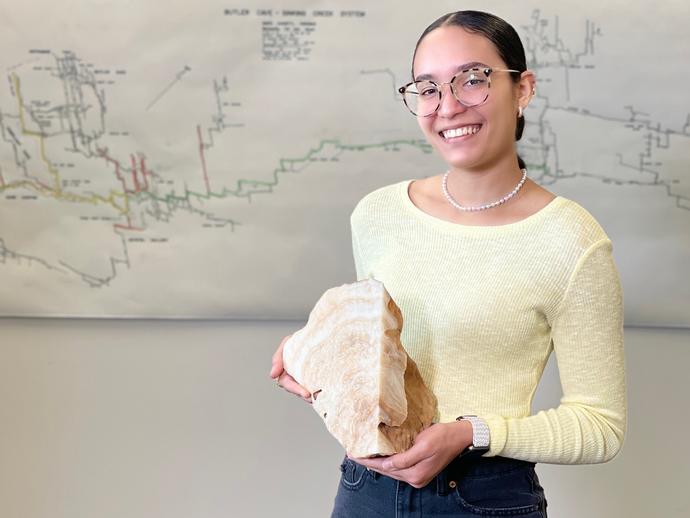December 4, 2024
The Virginia Museum of Natural History (VMNH) has awarded Dr. Ángel A. García, Jr., Assistant Professor of Geology and Environmental Science at James Madison University, a grant of $5,000 in support of an undergraduate research opportunity aimed at answering key questions about cave shields. The grant is made possible by the museum’s Pete Henika Memorial Fund, an endowment fund supporting high-impact research projects in the field of geology and other natural history disciplines.
"More than a tenth of the world’s ice-free surface is a mysterious zone where natural waters dissolve rocks, creating complex and unpredictable hydrological drainages, caves, and fascinating landscapes known as karst," said García. "For years, researchers have been captivated by speleothems (cave formations), which offer valuable insights into past climates and extinct flora and fauna. Today, scientists continue to use these records to unravel the intricate dynamics between the ground and the atmosphere in karst environments. Among these formations, cave shields, are rare speleothems found in some caves around the world."
Oval or semi-oval speleothems that grow in pairs, cave shields are divided by a hairline fracture from the walls, ceilings, and in some instances near the ground of a cave. First described in 1952, these formations have not been widely researched due to their relative rarity and inaccessibility. However, in the Shenandoah Valley, numerous caves contain diverse specimens of shields, presenting García and students with a unique opportunity to research their formation, age, and the environmental trends that they may record.
"This past summer, we acquired a fraction of a shield, which, after being polished, revealed itself to be a representative sample of the lower plate of a shield with a lot of promise for the study of such rare speleothem," said García. "The acquired sample provides a clear representation of the concentric layers, offering a great opportunity to study aspects such as oxygen isotope equilibrium in the layers, trends of carbon and oxygen, and the construction of an age model to understand are the diverse mechanisms contributing to the formation of cave shields."
To help advance this investigation, García will use the Pete Henika Memorial Fund award to support an undergraduate research opportunity aimed at answering key questions about the cave shields.
"This funding will enable us to delve deeper into the formation processes, age, and possible environmental records preserved within these rare speleothems, contributing valuable knowledge to the field of cave and karst studies," said García. "The involvement of undergraduate students in this research is crucial, as it provides the students with hands-on experience in fieldwork and laboratory analysis, develops their research skills, fosters mentorship and collaboration, and prepares them for future careers in geosciences and environmental science."
Upon completion of the research, García plans to share the results with the museum to ensure that the findings are accessible to both the scientific community and the general public. Additionally, the cave shield sample will be donated to the museum for future public exhibition.
"The Pete Henika Memorial Fund was designed specifically to help facilitate the type of impactful research that Dr. García and his students are conducting," said Dr. Joe Keiper, Executive Director of VMNH. "We look forward to following the progress of their research and learning more about Virginia’s rich geological story."

 Hours & Admissions
Hours & Admissions Directions
Directions

